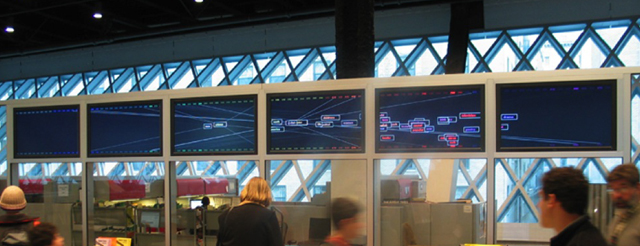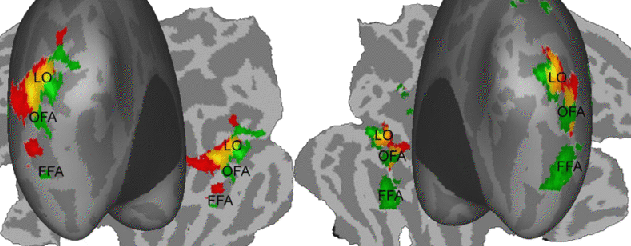///Data is Beautiful Symposium Wednesday, 3rd October 2012
Hungarian University of Fine Art, Intermedia Department, Kmety u. 27, 1063, Budapest.
10.00 pm Doors open
10.30 pm Welcome Speech: Prof. Miklós Peternák, President of the Doctoral Council and Chair of Intermedia Department, Hungarian
University of Fine Arts
/// Chairs: Miklós Peternák, Zoltán Szegedy-Maszák, Brigitta Zics
///Please see detailed schedule here.
//SYMPOSIUM REGISTRATION IS OPEN NOW
/////////////////////////////////////////////////////////////////////////////////
///Speakers
George Legrady ///Four Public Space Installations that Collect Data and Feature Feedback///
For the talk I will present four public installations that visualize data collected on-site. They include Pockets Full of Memories (2001-2007): A direct “crowdsourced” artwork, where the audience contributes information by scanning and describing an object in their possession. Making Visible the Invisible (2005-2014) is an “indirect crowdsourced” artwork at the Seattle Central Library. Patrons’ check-outs of books, dvds, cds are statistically analyzed and dynamically visualized. We Are Stardust (2008) is a commission by the NASA Spitzer Science Center. The installation maps the observations of the sun-orbiting Spitzer heat-sensing satellite telescope. In Cell Tango (2006-2009), the public contributes cellphone images that search Flickr for other images based on tags.
Brigitta Zics ///Data is Beautiful: From Data Perception to Data Aesthetics///
This talk explores data aesthetics and its role in constructing human knowledge. It explains beauty as an integral part of knowledge acquisition, which plays a crucial role in generating new, or enhancing existing, information. It looks at the representation and abstraction of data in relation to embodied human experience and data aesthetics. The talk also touches upon (i) how the design of information spaces requires an understanding of the limitations of human perception and (ii) how new motion and emotion aware systems can provide a new framework for aesthetics to enhance the acquisition of knowledge.
David Link ///The Resurrection of Draughts. On Data Visualisation and I/O in the 1950s///
The talk will present the resurrection of a software from the beginnings of computing, Christopher Strachey’s program for the game of draughts from 1951. It was developed on the Ferranti Mark 1 in Manchester, probably the first computer worldwide. The algorithm is the earliest on a computer to display data on a CRT at all. An interesting part of the algorithm simulates an ENTER key.
Nina Czegledy and André Czegledy ///Spectacle and Mediation: The Body Visualized///
The history of bodily visualization is ably represented in the field of medical science. The development of advanced biomedical technologies, particularly those linked to visualization, has radically changed the relationship between subject/patient and the agency of diagnosis and/or bodily interpretation. Imaging systems and visualization techniques, have successively contributed to a significant shift to multiple perceptions of the human body. This has led to a situation whereby the visual material of our bodily reality is increasingly supplied through a variety of technological means and the corporeal is now often seen in ways distinct from human vision, and completely dependent upon the mechanics of biomedicine. Our discussion focuses attention on how the new perspectives of biomedical visualization have inspired artists, to produce novel aesthetic and artistic creations. The work of these artists investigates the intersecting nexus of conceptual art and medical science and technology which highlights new insights in interpreting the physical self. (Image credit: Justine Cooper, 1998)
Marian Dörk ///From Searching and Browsing to Visual Exploration///
While information on the Web is becoming increasingly abundant, diverse, and dynamic, web-based graphics and interactivity are becoming more and more advanced. To find better ways for making sense of growing information spaces, I create interfaces that pick up on current technical trends to support information practices embodied by the information flaneur. In this presentation, I will present two related case studies: visual query widgets (VisGets) and a zoomable search environment (Fluid Views). First results of these projects suggest novel forms of information seeking, during which visualizations can help the searcher to gain a sense of overview and orientation.
Gyula Kovács///How neuroscience manages to present 4D data in 2D///
The last years witnessed the intensive development of methods which test the functions of the living human brain. These methods usually create a vast amount of three dimensional data as a function of time. One of the biggest challenge of such current studies is to find the best way to present their data on a flat screen in two dimensions. In our current lecture we briefly summarize the current trends in functional imaging data presentation and present examples of the most modern trends.










